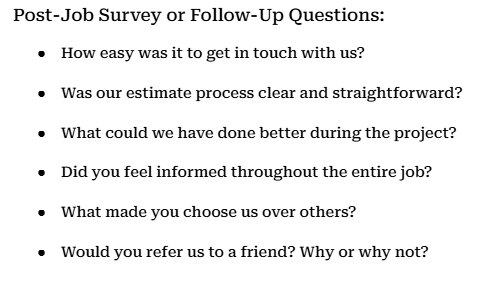Customer Journey Mapping for Painting Contractors: How to Optimize Every Stage of the Customer Journey for Growth and Constant Improvement
Whether you’re a solo painter or running a growing crew, understanding your customer journey is one of the most powerful ways to create loyal clients, build referrals, and grow your business with intention. Here's how to break it down, document it, and level it up.
Introduction: Why the Customer Journey Matters
Before a single brush hits the wall, your customers are already forming opinions about your business. From their first Google search to the final walkthrough, every interaction shapes how they feel about your work.
Understanding this journey helps you:
Identify gaps in communication
Improve efficiency and reduce friction
Create a memorable experience that turns clients into raving fans and referrals
What is the Customer Journey in a Painting Business?
The Customer Journey refers to every touchpoint a client has with your business, from discovery to post-project follow-up. For painters, this typically includes:
Awareness – The client hears about your business (ads, word of mouth, Google, etc.)
Consideration – They research you (website, social media, reviews)
Inquiry – They reach out (call, email, form fill)
Estimate & Consultation – You meet, assess the project, and provide a quote
Booking & Scheduling – The client decides to move forward
Prepping & Painting – The actual work is performed
Completion & Review – Final walkthrough and feedback
Follow-Up & Retention – Post-job thank you, requests for reviews, and future offers
How to Document the Customer Journey (Step-by-Step)
✅ Step 1: Map Your Current Journey
List out each stage (use the 8 steps above as a guide). For each stage, ask:
What is the customer doing here?
What is the business doing? Who is responsible for what task and when?
How is the customer feeling?
What tools or communication methods are being used?
Example: During “Inquiry” – the customer is probably waiting for a fast reply. If your response takes 2 days, that's a friction point.
✅ Step 2: Use a Visual Tool
Use tools like:
A whiteboard or sticky notes
A spreadsheet or table (like the one pictured; link below to download and use ours)
Online tools like Miro or Lucidchart
✅ Step 3: Highlight Gaps or Pain Points
Mark any points where:
Clients drop off
There’s confusion or back-and-forth
Delays or miscommunication happen
Questions to Ask Your Customers to Uncover Gaps
Asking the right questions can uncover blind spots in your process. Try these below.
You can do this via:
A quick email or text survey
A follow-up call
A printed postcard left after the job
Or even in person at the end of a project
How to Track and Adjust the Process for Ongoing Improvement
Use a Simple CRM or Project Tracker
Even a tool like a custom spreadsheet in Google Sheets or Excel can help you or utilize a paid CRM to:
Track leads and customer stages
Keep notes on interactions
Set reminders for follow-ups
Review Metrics Monthly or Quarterly
Some key metrics to review:
How many leads turn into booked jobs?
Where are leads coming from?
How long from inquiry to job start?
Quantity of customer reviews, star ratings or testimonials
Create a “Customer Journey Toolkit”
Keep it simple. Include:
Email templates for each stage
A checklist for onboarding clients
Standard Operating Procedures (SOP’s) for your team
Pre-job and post-job communication scripts
A follow-up schedule
Improve One Step at a Time
Pick one friction point per month to improve. For example:
Add a welcome email after an estimate is sent
Automate reminders for scheduled jobs
Streamline the final invoice and review request process
Review and track repeated tasks; Ask yourself what can be automated to save time?
Conclusion: Small Improvements Lead to Big Wins
Your painting business doesn’t need a fancy system—just a clear process, a bit of empathy, and willingness to improve. By understanding and optimizing your customer journey, you build trust, increase referrals, and stand out in a competitive market. You also allow yourself to visualize where you can make the necessary improvements, as well as the utilization of technology and automations. No customer journey is concrete; allow it to change and morph as you grow or as your customer’s needs change.




